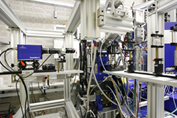Optically accessible engine

Aim
The development of modern internal combustion engines requires the observation on in cylinder processes. Laser diagnostics methods allow for the observation of fluid flow fields, fuel/air mixture formation, ignition and pollutant formation. The IVG single cylinder engine is fully optically accessible through a quartz ring replacing the upper part of the cylinder liner and a large scale sapphire window in the piston. Therefore, the combustion chamber can be observed from multiple directions and accessed with laser beams. In combination with the versatile laser equipment located in the neighboring laboratory and a number of intensified scientific cameras the facility can be used to develop laser diagnostics methods, to contribute to the development of engine combustion strategies and to provide measured data for the validation of numerical simulations. A comparable combination of laser diagnostics capabilities and the equipment available in the optical engine facility is only available in few labs worldwide.
Approach
The revolution speed of the optically- accessible single cylinder engine (bore: 84 mm) is controlled by a dynamometer (up to 3000 rpm). It is currently set up as an spark-ignition engine with direct injection. Fuel can also be supplied via port-fuel injection. Depending on the application piston and cylinder head can be exchanged for different geometries. The facility is fully equipped with standard engine measurement technology and data logging. It features exhaust gas analytics and fast gas sampling from the combustion chamber. Oil and water temperature is electrically controlled. A wide variety of laser sources (Excimer, Nd:YAG-, dye, high-repetition-rate laser) is available from the neighboring air conditioned laser lab through ports in the wall of the engine test cell. A hydraulically controlled stage holds the quartz ring that provides optical access to the combustion chamber. The window can be removed within minutes to allow for easy cleaning. The engine is operated from a neighboring control room.
References
C. Schulz "Advanced laser imaging diagnostics in combustion," Z. Phys. Chem. 219, 509-554 (2005).
Contact
Prof. Dr. C. Schulz, Christof Schulz, Tel: +49 (0)203 - 379 8161, IVG

